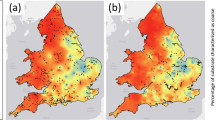Abstract
Unexpected habitat innovations among invading species are illustrated by the expansion of dreissenid mussels across sedimentary environments in shallow water unlike the hard substrates where they are conventionally known. In this note, records of population characteristics of invading zebra (Dreissena polymorpha) and quagga (Dreissena bugensis) mussels from 1994 through 1998 are reported from shallow (less than 20 m) sedimentary habitats in western Lake Erie. Haphazard SCUBA collections of these invading species indicated that combined densities of zebra and quagga mussels ranged from 0 to 32,500 individuals per square meter between 1994 and 1998, with D. polymorpha comprising 75–100% of the assemblages. These mixed mussel populations, which were attached by byssal threads to each other and underlying sand-grain sediments, had size–frequency distributions that were typical of colonizing populations on hard substrates. Moreover, the presence of two mussel cohorts within the 1994 samples indicated that these species began expanding onto soft substrates not later than 1992, within 4 years of their initial invasion in western Lake Erie. Such historical data provide baselines for interpreting adaptive innovations, ecological interactions and habitat shifts among the two invading dreissenid mussel species in North America.
Similar content being viewed by others
References
Ackerman JD, Sim B, Nichols SJ and Claudi R (1994) A review of the early life history of zebra mussels (Dreissena polymorpha): comparisons with marine bivalves. Canadian Journal of Zoology 72: 1169-1179
Berkman PA, Haltuch MA, Tichich E, Garton DW, Kennedy GW, Gannon JE, Mackey SD, Fuller JA and Liebenthal DL (1998) Zebra mussels invade Lake Erie muds. Nature 393: 27-28
Borcherding J (1992) The annual reproductive cycle of the freshwater mussel Dreissena polymorpha Pallas in lakes. Oecologia 87: 208-218
Carroll SP and Dingle H (1996) The biology of post-invasion events. Biological Conservation 78: 207-214
Coakley JP, Brown GR, Ioannou SE and Charlton MN (1997) Colonization patterns and densities of zebra mussel Dreissena in muddy offshore sediments of western Lake Erie, Canada. Water Air and Soil Pollution 99: 623-632
Dermott R and Kerec D (1997) Changes to the deepwater benthos of eastern Lake Erie since the invasion of Dreissena: 1979–1993. Canadian Journal of Fisheries and Aquatic Sciences 54: 922-930
Dermott R and Munawar M (1993) Invasion of Lake Erie offshore sediments by Dreissena, and its ecological implications. Canadian Journal of Fisheries and Aquatic Sciences 50: 2294-2304
Elton CS (1958) The Ecology of Invasion by Plants and Animals. Methuen, London
Gale SJ and Hoare PG (1991) Quaternary Sediments: Petrographic Methods for the Study of Unlithified Rocks. Belhaven Press, New York, 323 pp
Galtsoff PS (1964) The American oyster, Crassostrea virginica Gmelin. Fisheries Bulletin of US Fish and Wildlife Services 64: 1-480
Griffiths RW, Schloesser DW, Leach JH and Kovolak WP (1991) Distribution and dispersal of the zebra mussel (Dreissena polymorpha) in the Great Lakes region. Canadian Journal of Fisheries and Aquatic Sciences 48: 1381-1388
Haltuch MA (1998) Modeling expansion of exotic mussels on Lake Erie sediments using Geographic Information Systems (GIS). Masters Thesis. The Ohio State University, Columbus, 115 pp
Haltuch MA and Berkman PA (1999) CD-ROM of Lake Erie Geographic Information System: Bathymetry, Substrates and Mussels. Ohio Sea Grant College Program, 1314 Kinnear Road, Columbus, Ohio 43214-1194, USA (http://www.sg.ohio-state.edu)
Hebert PDN, Muncaster BW and Mackie GL (1989) Ecological and genetic studies on Dreissena polymorpha (Pallas): a new mollusc in the Great Lakes. Canadian Journal of Fisheries and Aquatic Sciences 46: 1587-1591
Lewandowski K (1976) Unionidae as a substratum for Dreissena polymorpha Pall. Polskie Archiwum Hydrobiologii 23(3): 409-420
Liebenthal DL (1988) The Lake Erie sand and gravel industry in Ohio. Report on Ohio Mineral Industries, Ohio Division of Geological Survey, Columbus, p 5
May B and Marsden JE (1992) Genetic identification and implications of another invasive species of dreissenid mussel in the Great Lakes. Canadian Journal of Fisheries and Aquatic Sciences 49: 1501-1506
McQuest Marine Sciences Ltd (1991) Report on side scan sonar surveys on three sites in Lake Erie: Chicken and Hen Island, East Sister Island and Chickenolee Reef. Ministry of Natural Resources, Wheatley, Ontario (December 1991), p 26
Mellina E and Rasmussen JB (1994) Patterns in the distribution and abundance of zebra mussel (Dreissena polymorpha) in rivers and lakes in relation to substrate and other physiochemical factors. Canadian Journal of Fisheries and Aquatic Sciences 51: 1024-1036
Mills EL, Dermott RM, Roseman EF, Dustin D, Mellina E, Conn DB and Spidle A (1993) Colonization, ecology and population structure of the ‘Quagga’ mussel (Bivalvia: Dreissenidae) in the Lower Great Lakes. Canadian Journal of Fisheries and Aquatic Sciences 50: 2305-2314
Mills EL, Rosenberg G, Spidle AP, Ludyanskiy M, Pligin Y and May B (1996) A review of the biology and ecology of the quagga mussel (Dreissena bugensis), a second species of freshwater dreissenid introduced to North America. American Zoology 36: 271-286
Nalepa TF and Schloesser DW (eds) (1992) Zebra Mussels: Biology, Impacts, and Control. Lewis Publishers, Boca Raton, 810 pp
Ram JL and McMahon RF (1996) Introduction: the biology, ecology and physiology of zebra mussels. American Zoology 36: 239-243
Schloesser DW, Nalepa TF and Mackie GL (1996) Zebra mussel infestation of unionid bivalves (Unionidae) in North America. American Zoology 36: 300-310
Spidle AP, Marsden JE and May B (1994) Identification of the Great Lakes quagga mussel as Dreissena bugensis from the Dnieper River, Ukraine, on the basis of allozyme variation. Canadian Journal of Fisheries and Aquatic Sciences 51: 1485-1489
Sprung M (1992) The other life: an account of present knowledge of the larval phase of Dreissena polymorpha. In: Nalepa T and Schloesser D (eds) Zebra Mussels: Biology, Impacts and Control, pp 39-54. Lewis Publishers, Boca Raton
Stanley SM (1972) Functional morphology and evolution of byssally attached bivalve molluscs. Journal of Paleontology 46: 165-212
Trask PD (1955) Recent Marine Sediments. Society of Economic Paleontologists and Mineralogists, Tulsa
Rights and permissions
About this article
Cite this article
Berkman, P.A., Garton, D.W., Haltuch, M.A. et al. Habitat Shift in Invading Species: Zebra and Quagga Mussel Population Characteristics on Shallow Soft Substrates. Biological Invasions 2, 1–6 (2000). https://doi.org/10.1023/A:1010088925713
Issue Date:
DOI: https://doi.org/10.1023/A:1010088925713




